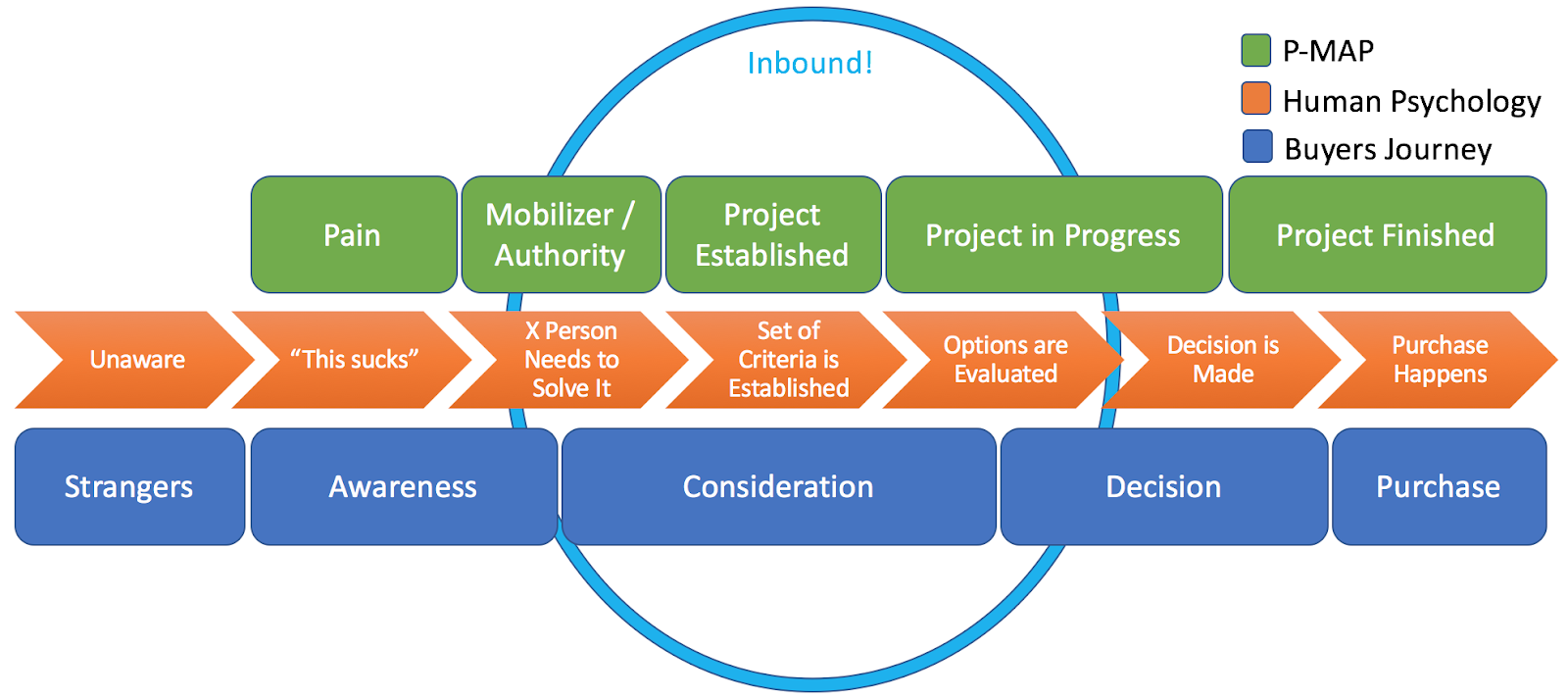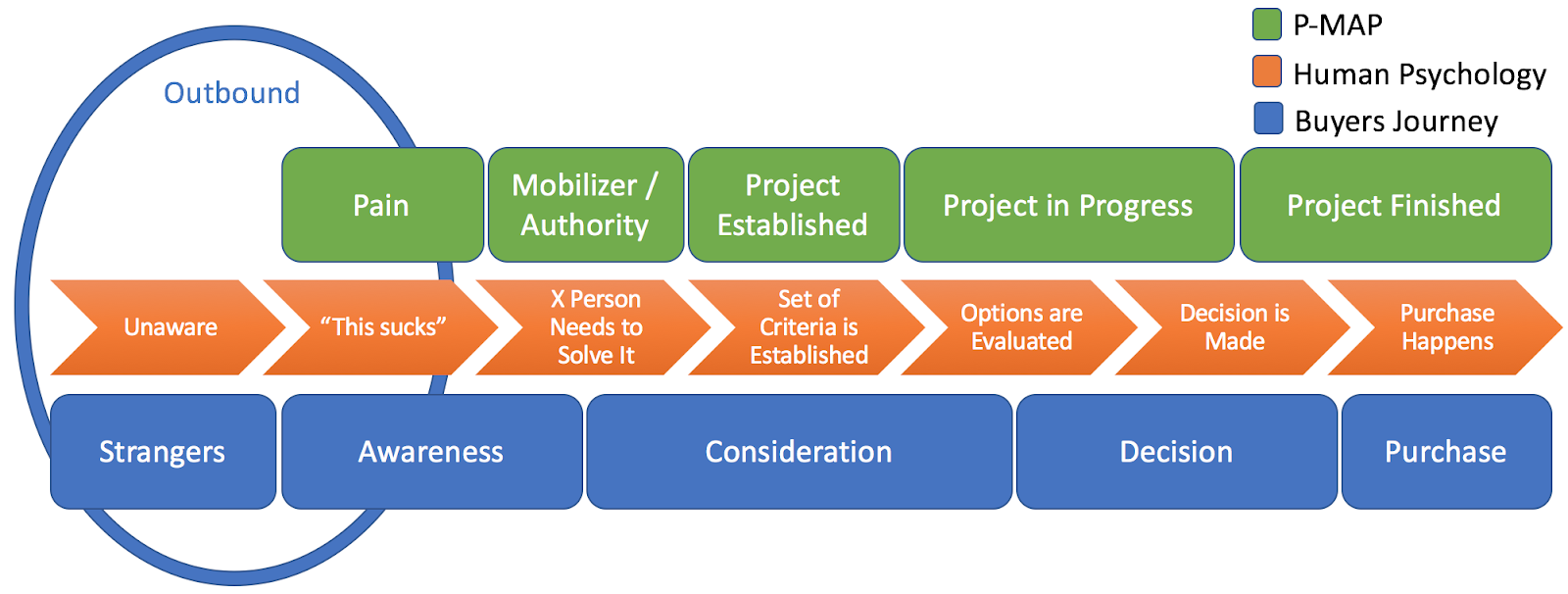Let’s explore how to run top-notch discovery calls and avoid the biggest outbound prospecting mistakes AEs are making.
I previously wrote a Sales Hacker article deconstructing Lead Qualification, where we explained the Buyer’s Journey, overlaid with human psychology and the “P-MAP” qualification criteria.
Here’s a picture from that article:

I also recently explained that there’s not a clear agreement on where to draw the line between “inbound” and “outbound”, many times causing companies to be confused regarding the classification of trade show scans and webinar attendees.
Therefore having Inbound, Warm Outbound and Cold Outbound is a better way to set clear boundaries. The definitions for these are helpful to understanding this blog, so please skim through those before you continue.
Now that you understand the difference between these 3 buckets, we need to further understand where the prospect’s mind is at when they show up to the “demo” or “intro call”. The reason for this is that unless you align your presentation with the prospects needs and their stage in the Buyer’s Journey, you’re unlikely to win them over.
Article overview:
- How to do an Inbound Discovery Call (for context)
- Outbound Discovery Calls: What NOT to do
- Running an Outbound Discovery Call
- How to get someone through a Buyer’s Journey
- The key to unlocking success with your outbound prospecting
How to do an Inbound Discovery Call (For Context)
It seems to me that all AEs learn how to run Inbound Discovery calls, as these are the easiest. The prospect is showing up to the meeting after already having engaged with your website and content. They have sent a request to meet with you because they perceive you can help them with a current initiative.
Sometimes they even have requirements and a budget assigned to this. In short, they are further down the funnel and further along their buyer’s journey:

Most AEs are really good at managing Inbound demos. They ask great discovery questions such as:
- What drove you to talk to us?
- Do you have other options are you considering?
- In terms of requirements, what do you need for this initiative? How will you measure success?
- What is the deadline for implementation, or when are you hoping it’ll be up and running?
- Tell me more about who else needs to sign off on this? Who else will this affect?
- Have you determined a budget for this project yet?
You can call it BANT, MEDDIC or some other acronym, but the purpose of these questions in sales is to learn things the prospect already knows.
When a demo is coming inbound, a lot of these questions can be answered quite quickly because they have a defined pain and an active project to solve it.
Maybe they don’t have the full criteria yet, but with a bit of work, you can align yourself with their needs.
How NOT to run Outbound Discovery Calls
The biggest problem I see with AEs is that instead of understanding the principles behind the Buyer’s Journey and how companies make purchases, they focus on their own “Discovery Call Process.”
What this means is that rather than helping the prospect, the AEs just show up at the Discovery and do the “show up and throw up” on the Discovery Call asking the same “inbound-driven questions.”

Unfortunately, the prospect is not yet at a point where they have answers to your questions, and therefore the majority of your deals die immediately after a demo.
I have even seen companies that don’t pay their SDRs unless the AE marks a demo Qualified, and establish the qualification criteria to be our ‘inbound-driven’.
That’s a recipe for failure. (Here’s how to fix that problem)
Here’s a 2-minute example:
How to Run an Outbound Discovery Call
So rather than inbound-driven questions, when doing Outbound prospecting demos you should ask problem-based questions.
Focus on why they need to change the current situation and educate them on what the GAP is between where they are today and where they could be if they made these changes.
You should also show that you have done the research necessary to get context and not ask dumb questions. By running a problem-oriented Discovery call, you will be able to move your prospects from “Strangers” to “Awareness” and then to “Consideration”.
You will be helping them recognize the challenge or opportunity they have in front of them.
Once on the Consideration stage, the prospect will start evaluating other vendors, as they look for a comparison to your solution. If you have really reached out to your ICP and you have helped them shape how they think about this challenge/opportunity, your solution will be positioned many steps ahead of the competition.
Remember, early on there’s no competition, there are no requirements, there’s no perceived “pain”, there are no KPIs or launch date.
You have to work to get them there. Think again, is your qualification criteria for Outbound all messed up? Focus outbound demos on the problem, not the solution 😉
Here is a good flow for a cold outbound discovery call (7 minutes):
If your AE tells you that prospects are not interested, do not blame the SDR, train the AE instead. Here’s the key learning of today:
The purpose of an SDR is to bring ‘curious’ prospects to the AE. The AE is responsible to uncover pains, challenges, and opportunities and create interest.
The economic sale is made when the contract is signed, but the psychological decision to buy is made much earlier on, when the prospect becomes a fan of how your product can help him. That’s what the best AEs are good at, creating fans.
How to Get Someone Through a Buyer’s Journey
Finally, we need to recognize that some of these Discovery Calls are neither inbound nor cold outbound. This is the tricky “warm outbound” leads that require further adaptability.
For example, when you get a referral, or when you get a trade show scan re-engaged after 3 months. Some of these might already have a small need or might have brand recognition for your company, there’s some awareness, but most likely there’s no “initiative”.
In these cases, you still need to understand what the prospects are trying to get out of the conversation. Below is a checklist you can use to nudge the conversation and move the prospect to the next stages.
Awareness:
- Awareness that they have a challenge or opportunity
- Knowledge that solutions exist
- Understanding of the quantifiable impact of this challenge or opportunity
- High-level understanding of the investment needed (money, time, effort, etc.)
After those points are clear, the prospect is fully aware and can move to the next stage.
Consideration:
- Who will be the person or people responsible to lead this initiative?
- Agreement that the cost of no-action is higher than the cost of the solution.
- How will success be measured?
- Who else will be affected by this project? Are they on board?
- Are there any compelling events, or a desired timeline?
- What will be the process to evaluate solutions? How will the decision be made?
After all those steps, the prospect can safely move to a decision and purchasing process. At this stage, you have gotten a verbal commit, and you are going through legal, procurement, security review, or whatever other criteria you need to pass. The psychological sale is made.
Finally, when the paperwork is done, they purchase.
The Key is to Define Roles and Train for Discovery Calls
The hardest part of a sale is always to drive a prospect form being a stranger, to choosing you as a vendor. Too many organizations are failing despite the fact that their SDRs do a good job of creating curiosity in the prospect’s mind. These prospects give your company a chance to show them value, yet the AEs who “show up and throw up”.
The death zone is killing your deals and your company. You need to take action, you need to train your AEs, not on closing techniques, but on Discovery Calls. You need to define what is the role of your SDRs, and who is in charge of helping prospects find the gap.
If you ask me, here’s what I would tell you:
SDRs: find complete strangers and make them curious about our solution. Have them accept a meeting
AEs: Get curious people and show them the challenge or opportunity ahead, help them quantify it and take action.
When deals come inbound, the sale is easier as you need to meet requirements, rather than build them. However, the sales also tend to be hyper-competitive, and the deal sizes are smaller.
Outbound might mean a much more difficult Discovery process and longer sales cycles, but it also means bigger deals, less competition, and a more scalable, and sustainable revenue engine.
Please let me know in the comments if this was helpful.
Need help with Outbound? I’ve built 23 teams through AltiSales, send me a message. Maybe I can give you a hand.
AltiSales is hiring experienced remote SDRs! You must be a top performer at your current company to qualify for an interview.
Submit your resume on our website: www.altisales.com/careers



